Wednesday January 01, 2014
The Quantum Index Analysis System
Paper presented at the 5th World Multiconference on Systemics, Cybernetics and Informatics ( Orlando, Florida, USA July 25, 2001)
Session : Computational Intelligence in Financial Systems
ALBERT CHEUNG
qindex@hotmail.com
Introduction
The Quantum Index Analysis is a new technical technique that I developed 20 years ago. This technique is used to forecast the movement of currency rates, prices in bonds, stocks and commodities. Using this system I provided exclusive service (USD/DEM, USD/JPY, USD/CHF and GBP/USD) to the Strategic Positioning Unit of Citibank in Hong Kong for two years (1988 - 1990). The URL of my website is http://www.qindex.com .
General Principle of Quantum Index Analysis (QIA)
QIA is a pc-based trading system which forecasts short term market movements on a daily, weekly or monthly basis. The system specifies projected chart points for a defined time frame (i.e. daily, weekly and monthly) and determines the ease of movement between these points. These projected chart points represent positions where one would expect market resistance or supporting force. Accurate determination of the position of these projected chart points is very important for traders to decide their entry and exit points. QIA is an ideal system for traders because it can predict the market direction and the high and low for a defined period.
The QIA System
Cycle Analysis
Daily closing data are used to generate the daily cycle charts. For currency rates, the reference point is 22.00 GMT. In weekly and monthly cycle charts, the immediately preceding weekly and monthly data are used as the basis of analysis. To obtain optimal conditions the last 25 samples are always used to generate the projected profiles. The overall time required to produce a complete set of raw data from a personal computer is generally less than one minute.
Frequency and Probability Charts
QIA generates a bar chart which indicates the ease of movement between projected chart points within a specific time frame. The system determines a projected range and produces a number of bars with a constant increment to cover this range in a chart. The bars are arranged in ascending order along x-axis. A value, frequency (y-axis), is assigned to each bar. The difference in frequency value of two adjacent bars indicates the ease with which the market is likely to move between them : the smaller the difference, the easier the movement, and vice versa. The system also assigns a probability value (y-axis) to each bar. The probability value measures the pull exerted by each bar on the market. The distance between any bar and the market position is a function of its pulling ability. The projected chart point adjacent to the market position is the projected chart point that is most likely to influence the way the market moves.
Normal Trading Range
Only the middle session of the projected profile is considered as the normal trading range. The width of the middle session is determined by half the height of the projected profile in the frequency chart. In general the market has 80% chance of closing within the normal trading range. If the market is trading outside the normal trading range, it is used as an early indication that the market is changing its rhythm.
Projected Chart Points
These are positions where one would expect the market to face resistance or supporting force. They are located at the tops of the projected profile. In the QIA system we try to generate a set of four to five projected chart points within the normal trading range. The projected chart points act like a super magnets. Occasionally, we also take note of those positions at the bottom of the projected profiles. They act like an equilibrium between two projected chart points. The likelihood of seeing a particular rate or price reached during any projected period is measured by a combination of two factors: the contour of the frequency chart and the probability value.
The Critical Point
This is a projected chart point positioning at the center position of the projected profile. Usually it has the highest frequency number and the highest probability value. Occasionally this is a set of two different projected chart points located adjacent to each other. I would label it as the "critical level". When the market is undecided, it has a tendency to move around the critical point with a magnitude of plus and minus one adjacent bar in the projected profile. When the market gathers enough momentum to move upward, it will move away from the critical level and head for the next projected chart point on the right hand side of the projected profile. The market has a tendency to stop at the upper limit of the normal trading range. When the market loses its momentum, it will reverse its course and pull back towards the critical level. On the other hand when the market builds up enough selling pressure, it will move away from the critical point and head for the next projected chart point on the left hand side of the projected profile. If there is constant selling pressure, the market will stay at the lower end but within the normal trading range until the end of the cycle.
Trading Strategy Using QIA
Market Rhythm
It is very important for a trader to determine the market rhythm first because it has a bearing on how the daily, weekly, monthly or quarterly charts would be used. If the market is very volatile, one should concentrate on the weekly and monthly charts. Daily cycle charts can then be used for fine tuning for exit or entry. 70% - 80% of the time, most market movements can be described by the daily and weekly cycle charts. In the QIA system all my projected chart points are interrelated and are separated by a multiple of a constant which is represented by an equal increment between bars in the charts. Projected chart points are positioned at the tops of a projected profile. One can easily fine tune the system engine to produce a set of points closely correlate to the position of high, low and closing prices. We can also sacrifice accuracy to a certain extent to generate a set of 3 to 4 significant chart points.
Trading Outside the Normal Range
When the market breaks through the daily cycle's normal trading range, weekly and monthly cycle charts should be used as reference. If the market is trading outside the weekly cycle's normal trading range, it is a warning signal for a trending market. In a strong trending market, 5-day and 22-day cycle charts will be used in addition to the daily, weekly and monthly charts.
Oversold and Overbought Condition
Under extreme circumstances the system will fail to generate the probability chart. Such a market condition is then defined as oversold or overbought. There is a great uncertainty but the market will have a very high tendency to reverse its course.
Pattern Recognition
The distribution of the bars in the projected profile offers some insight into the market movement. A projected profile with several prominent peaks would suggest a range trading market. On the other hand a projected profile with only one symmetrical peak would indicate that a trending market is developing.
Determination of entry/exit points
The odds are in one's favor if entry or exit points are positioned at the extreme end of the normal trading range of the daily or weekly cycle charts or in the vicinity of a projected chart point in the monthly chart. There is less than 20% - 30% chance for the market to close outside the weekly and daily cycle's normal trading range
Stop loss placement
The stop loss level should be placed at 1 - 2 bars away from the entry point. Entry or exit points should be positioned in the vicinity of projected chart points in the weekly or monthly cycle charts. The market has a 70% - 80% chance of closing within the normal trading range in the daily and weekly cycles. When a new position is opened, the projected profit and loss ratio should always be maintained at a value of greater than 1.5.
Examples
Monthly Cycle Charts
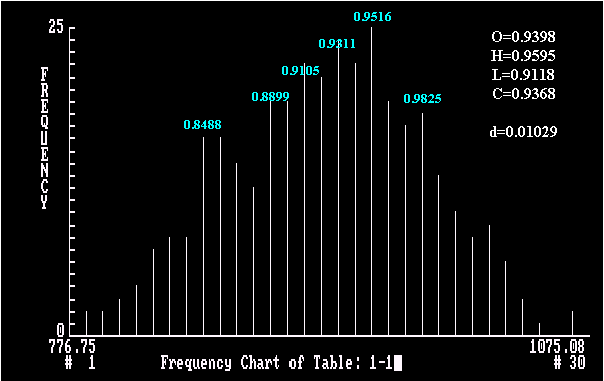
EUR/USD : Monthly Cycle Frequency Chart for January
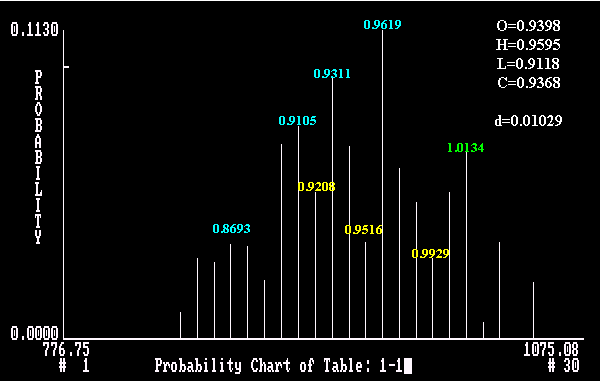
EUR/USD : Monthly Cycle Probability Chart for January
The market movement for Euro in the month of January was used as a study case. The system examined a projected range of 0.77675 to 1.07508 and used 30 bars to cover the projected range. Each increment is represented by 0.010287. The normal trading range is 0.8488 - 0.9825. The market opened at 0.9398 and faced resistance at 0.9515 initially. It retraced 250 pips to 0.9265 and then gathered momentum to tackle the projected chart point at 0.9619. As shown in the monthly cycle probability chart the projected chart point at 0.9619 had the highest probability value associated with it. Although the projected chart point at 0.9619 has the highest pulling force, the monthly cycle frequency chart indicates that there was a good gap between 0.9515 and 0.9619 as measured by the difference in their respective frequency number. If the market momentum was strong enough to overcome resistance at 0.9619, EUR/USD could easily test the next projected chart point at 0.9825 and eventually tackle 1.0134. As it turn out the market hit the monthly cycle high at 0.9595 and then retreated to 0.9379. It managed to overcome resistance at 0.9516 and hit 0.9580. It was then apparent that a strong resistance level has been established at 0.9516 - 0.9619. The market then pulled back all the way to 0.9118. At the end of the month EUR/USD managed to settle around 0.9368.
Weekly Cycle Charts
First Week
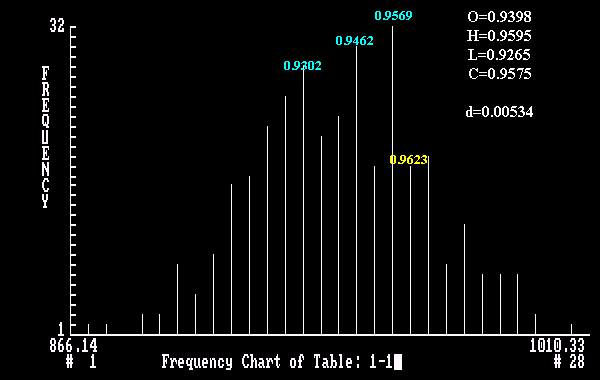
EUR/USD : Weekly Cycle Frequency Chart for January (1st Week)
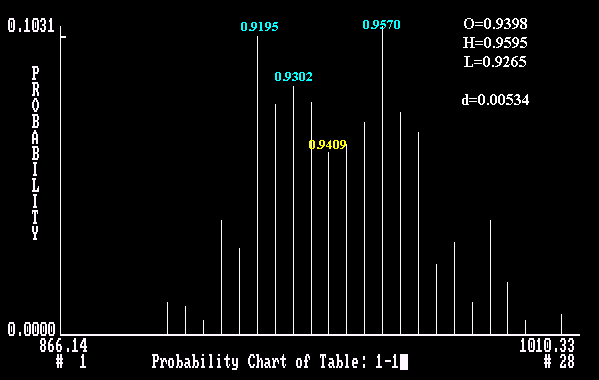
EUR/USD : Weekly Cycle Probability Chart for January (1st Week)
In the first week of January the market moved ahead and tackled the projected chart at 0.9570. It met resistance at 0.9570 - 0.9595. The pattern of the weekly cycle probability chart suggested a range trading between 0.9195 and 0.9570, as indicated by the high probability values associated with these two projected chart points. The market found support at 0.9265 - 0.9269 and closed higher at 0.9575.
Second Week
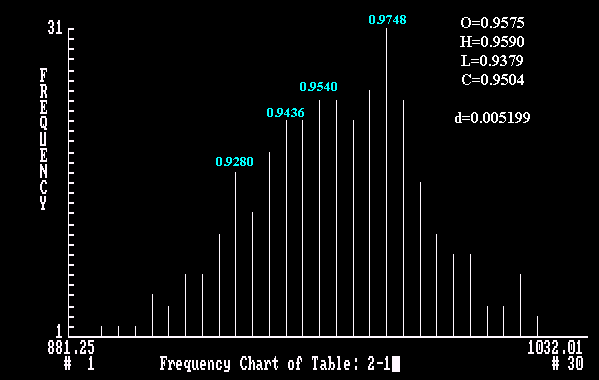
EUR/USD : Weekly Cycle Frequency Chart for January (2nd Week)
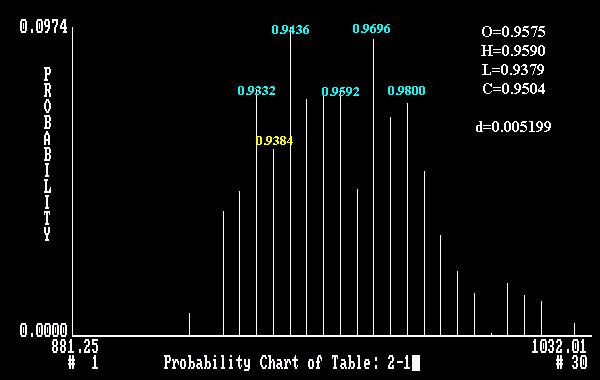
EUR/USD : Weekly Cycle Probability Chart for January (2nd Week)
In the second week of January the pattern of the weekly cycle probability chart suggested a range trading between 0.9436 and 0.9696. As shown in the chart below, a gap was found between 0.9592 and 0.9696. The market failed to go higher than 0.9590. This was an early indication of market weakness. However it found support at 0.9379 - 0.9385, which was higher than the supporting level of the previous week ( 0.9265 - 0.9269). It is interesting to note that a gap also exited at 0.9332 - 0.9436. Eventually EUR/USD found support around the mid-point between these two projected chart points. At the end of the week, EUR/USD closed at 0.9504.
Third Week
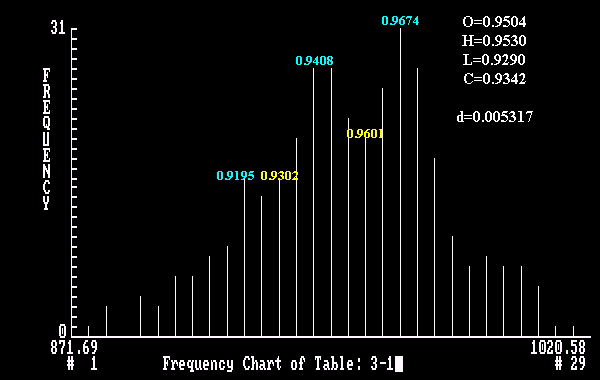
EUR/USD : Weekly Cycle Frequency Chart for January (3rd Week)
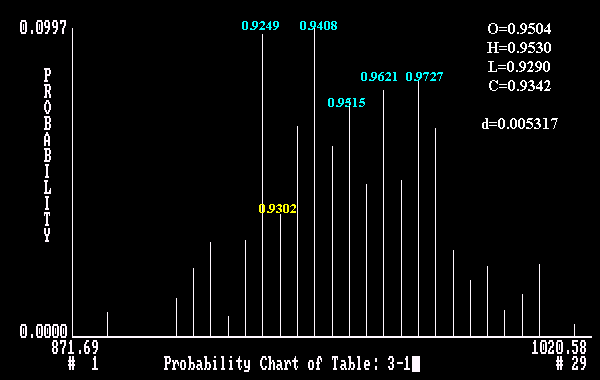
EUR/USD : Weekly Cycle Probability Chart for January (3rd Week)
In the third week, the pattern of the weekly cycle chart suggested that it was likely to trade within the range of 0.9408 - 0.9674. High probability value was associated with the weekly cycle projected chart points at 0.9249 and 0.9408, indicating that the market was subjected to a force pulling towards the lower end of the weekly cycle normal trading range. It is also important to note that there was a shifting in the profile range as determined by the system, from the previous week of 0.88125 - 1.03201 to 0.87169 - 1.02058. EUR/USD hit the high/ low at 0.9530 and 0.9290 respectively. In general the weekly market movement was very confusing. On the one hand the market was able to move away from 0.9249 - 0.9408 and managed to close at 0.9505. On the other hand it could not overcome the gap at 0.9515 - 0.9621 found in the weekly cycle probability chart.
The Fourth Week
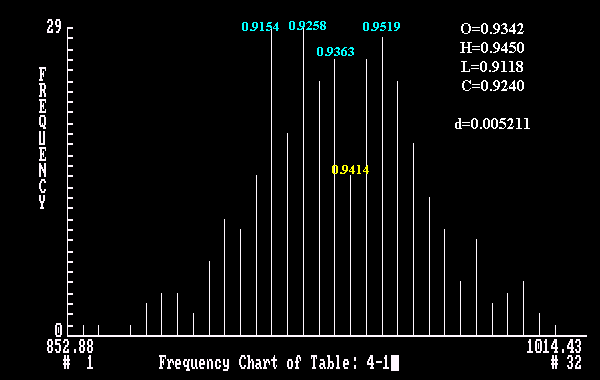
EUR/USD : Weekly Cycle Frequency Chart for January (4th Week)
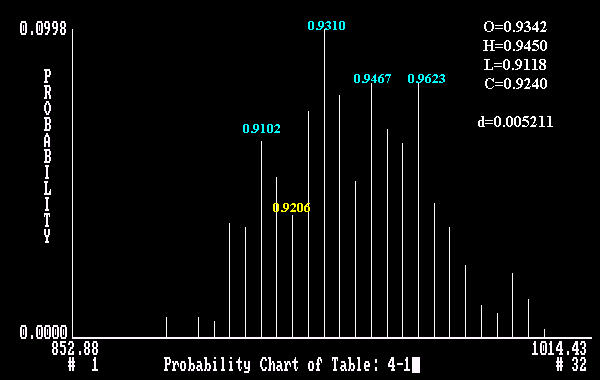
EUR/USD : Weekly Cycle Probability Chart for January (4th Week)
The shifting of the third week's projected profile to the lower end was obvious in the fourth week. The market moved from a range of 0.87169 - 1.02058 in the third week to 0.85288 - 1.01443 in the fourth. EUR/USD was able to penetrate through the previous supporting level at 0.9265 - 0.9269 and the market's downward momentum was sufficiently strong to drag it all the way to 0.9118. It did recover somewhat at 0.9315 on Friday and closed at 0.9240.
|
Projected Chart Points
|
|||
| Weekly | Monthly | 3 Months Projection | |
| Outside | |||
| Normal Trading Range | 0.8976 / (09081) | 0.8899 / ( 0.9105) | 0.8827 / ( 0.9072) |
| (0.9133) / 0.9185 | 0.9311 | 0.9318 | |
| 0.9342 | 0.9516 | 0.9563 | |
| 0.9447 | (0.9619) | (0.9808) | |
| (0.9551) | 0.9825 / 0.9929 |
1.0054 |
|
| Outside | |||
|
|
|||
|
General Trend : Euro will look much better if it can close above 0.9318 and 0.9105 should hold. Daily Comment : Hold on to your long position. |
|||
In practice a trading menu is provided for subscribers for reference. This is particularly important in a volatile market. For day traders the daily cycle projected profiles are a must.
Albert Cheung (Ph.D.) E-mail :- qindex@hotmail.com
Website : http://www.qindex.com